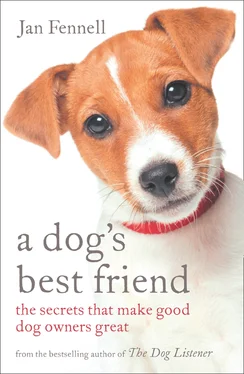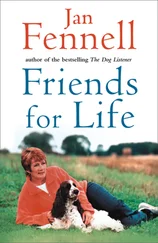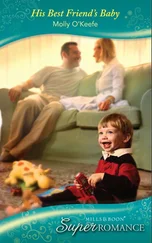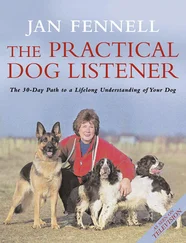‘Glad I caught you, Jan,’ he said, emerging from the front door. ‘I’ve given it a lot of thought and I think I’d like a dog.’
‘Oh, good for you,’ I said. ‘Have you decided on what breed you’d like?’
‘Well, if I could find a dog like your Ben, I’dbe delighted.’
Ellie shot me a look immediately, but she didn’t need to say anything.
‘Would you like Ben?’ I asked.
Jim was taken aback for a moment or two. ‘Well, I, er,’ he spluttered, not sure what to say.
Finally, I thought it was the right time to tell him Ben’s story. As I explained the situation, Jim’s face lit up.
‘Jan, I’d love to have him,’ he beamed.
Even then, I didn’t want to foist on Jim a dog that wasn’t right for him. So the moment I got home, I put Ben on a lead and walked him round to Jim’s house.
‘I’ll leave you two together for a couple of hours, to see how you get along here,’ I said. ‘I’ll be back to take Ben home later.’
I returned after I’d put the children to bed. I found Ben, snuggled up next to Jim’s armchair, looking every inch as if he was another piece of furniture.
‘So, Jan, could Ben stay?’ he asked simply, stroking Ben once more.
I thought he meant overnight, and so I explained that I didn’t think it would be good for Ben, especially as he’d just got over the upheaval of moving back from Sheffield.
‘Oh, not just for tonight. Can he stay for good?’ Jim said.
Ben was sitting at Jim’s feet now. The pair of them looked as if they were made for each other. I couldn’t help myself as the tears started rolling down my face.
‘Of course he can, Jim,’ I said, when I had eventually regained a little of my composure. ‘I can’t think of anywhere else I’d rather he stayed.’
The transformation was miraculous. About a week after Ben had moved in with Jim, I met a lady in the village shop.
‘I haven’t seen Jim Moss for two years, now I’ve seen him every day this week,’ she said.
Almost immediately, Jim had become one of the familiar sights in the village, striding along with Ben on his lead. Once a week, he and Ben would walk four miles to the nearest market town, where Jim would pop into a pub for a couple of drinks, then do his shopping at the market and walk back home again. He was once more the man he had been before Amy’s death – only now it was he and Ben who were inseparable.
It was many months later that I finally got to have a proper talk with Jim. I saw him in the village and he invited me in for a cup of tea and a chat.
The atmosphere in the house had changed completely from when I had last been there. Before, it was clear that everything was pretty much as it had been when Amy was alive. The house looked as if a woman lived in it – there were knick-knacks and feminine touches everywhere. Now it was very different. Amy hadn’t been forgotten – her picture still dominated the living room, and the flowers were as fresh as ever – but the rest of the house now reflected Jim’s personality rather than hers. He had redecorated and bought new furniture. The knick-knacks had gone and another photograph took pride of place on Jim’s mantelpiece – a lovely portrait of Ben.
Jim was obviously in the mood to talk and, as the tea flowed, he explained how important Ben had been to him. He confirmed what had been obvious to all of us who knew him. For the first two years after Amy’s death, he’d been a lost soul.
‘I hadn’t been able to come to terms with losing Amy. I couldn’t let go of her because I was all alone,’ he said. Ben’s arrival had provided him with company – and the strength finally to let go.
‘I hadn’t been able to grieve properly until I had him,’ he said. ‘When Ben arrived, I was able to start crying. He didn’t laugh at me for doing it, or stumble for the right words to console me. He just sidled up close and was there for me. That dog gave me a reason to live again,’ he told me. ‘Ben showed me my life wasn’t over.’
As so often happens, the dog had opened new doors for Jim. For some reason, people are more likely to strike up a conversation with someone who is walking a dog. And so it proved with Jim.
‘Ben has helped me make a lot of new friends,’ Jim explained. He told me his life was busier than it had ever been.
It was almost overwhelming to hear just how profound an effect this dog had had on Jim’s life.
Jim and Ben’s story has always remained with me, and it is an important one for a number of reasons. I am often asked to sum up what is so rewarding about having a dog. To be honest, it’s something I often find hard to put into words. On many an occasion I have used Jim’s story as the answer. To me, their story says more about the pleasures of owning a dog than any worthy, wordy statement. Jim and Ben were there for each other when it really mattered. And they rewarded each other with all the loyalty and love they could muster. I often think of the two of them walking down the country lanes together. If there’s an image of owner and dog in perfect harmony, then that’s it.
In the years that followed, as I delved deeper into our relationship with dogs, I came to realise he symbolised something more significant. Jim, as far as I was aware, wasn’t someone with experience of living with dogs. Yet, as I’d seen from the moment he and Ben had first met, he seemed to have a natural affinity, they seemed to trust and like him. When Ben had gone to live with him, they had built up a remarkably close bond. And again it seemed to have happened quite naturally. Jim never once came to me for any additional advice on looking after springers. I never heard of Jim attending any of the obedience classes that were popular in the area at the time. He just got on with it – with admirable results.
It was only years later, when I thought about that conversation with him, that it struck me what the key to his success must have been. It came to me when I remembered Jim with Amy all those years before. He had approached his relationship with Ben just as he had treated his marriage to Amy. When Amy had been alive, Jim had respected her. As he’d said himself, he hadn’t tried to change her, to mould her into something she was not. He had let her be herself – and she’d let him be himself.
Essentially, he had done the same thing with Ben. Jim had let his dog be himself and Ben had rewarded his master by allowing him to be himself at a time when he desperately needed to do so. With Ben around, Jim had finally felt free to cry openly and mourn. It was something so natural, yet at the same time so rare.
Of course, as we all know, relationships are not always this simple. Ordinary life can be much more complicated and demanding than this. People do have to change and make allowances for each other – and their dogs have to fit into their life as well. But within Jim and Ben’s story is an essential truth – something that has struck me as more and more important as the years have gone by: respect is the key to all great relationships.
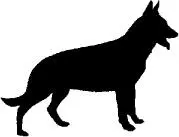
FEELING THE FORCE
The importance of drawing on the lessons of others
Formulating the ideas that make up my method of communicating with dogs was a slow, almost imperceptible, invisible process. There was no real eureka moment, no apples fell from the trees. For years, usually without my realising it, people or events provided me with pieces in a giant jigsaw puzzle. Then one day I looked down to see that jigsaw complete.

The short version of the story is this. As my involvement in the dog world grew through the 1970s and 1980s, I had begun to harbour a deep distrust of traditional training methods. I attended – and even ran – my fair share of classes promoting these views, but I felt more and more that they were too aggressive, too reliant on the domination of the owner and the subjugation of the dog to his or her will. I felt there had to be another way.
Читать дальше
